Wall Mount TV Brackets
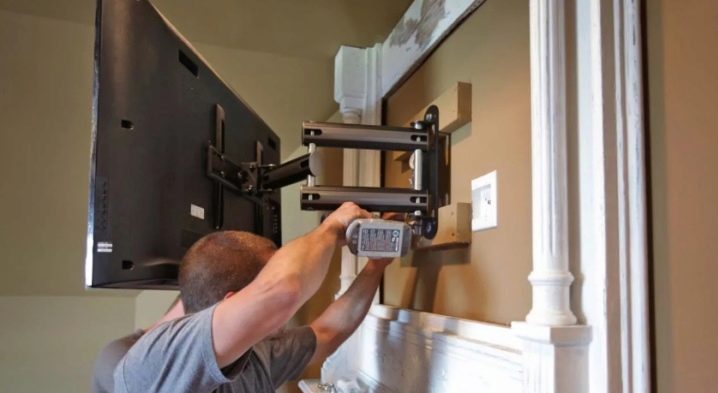
Before the modern flat-panel TV user came into life, the bracket was something of an outrage. The TV was installed on a pedestal or a small table with shelves, and few people seriously thought about placing it on the wall.
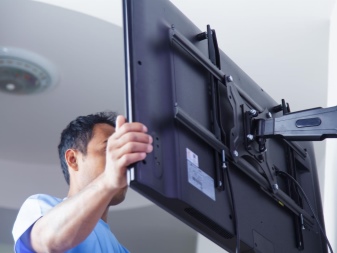

Peculiarities
The bracket is designed to be mounted on the wall of household appliances. It is characterized by some peculiarities.
- Suitable only for small - in terms of technological thickness - equipment. You can't hang a "pot-bellied" old-style TV, a washing machine, a microwave oven, etc. on it - not only because of its spacious dimensions, but also because of its considerable weight, which is 10 kg or more. Large and heavy devices do not look aesthetically pleasing in an apartment or a country house. In the recent past, hanging television cameras and other professional equipment was only the hallmark of television studios.
- Bracket requires through fastening... Although monitors, televisions, home theater kits and other LCD panels have been greatly lightened, it is recommended that you drill through the mounting points to prevent the device from falling off suddenly. For fastening, sections of studs with large (from 3 cm in outer diameter) press washers, spring washers are used to prevent sudden loosening and untwisting of the fasteners. The bracket itself is a steel (non-aluminum) tube.
Like any prefab gimbal, the TV and monitor bracket is a kit that contains everything, including the hardware. Some manufacturers include hex wrenches in the kit.


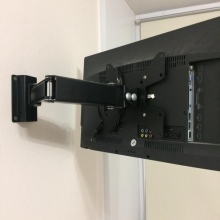
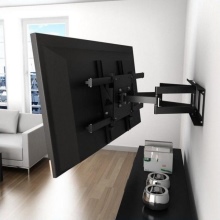
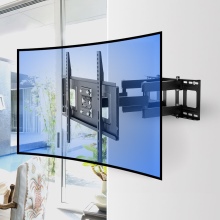
Views
Flat panel TVs and monitors can be easily positioned anywhere in the room by hanging them on the wall. Different kits differ in size and format of additional components, length and width of the main ones, without which, in turn, it will be difficult to hang the TV set. There are four main types available.
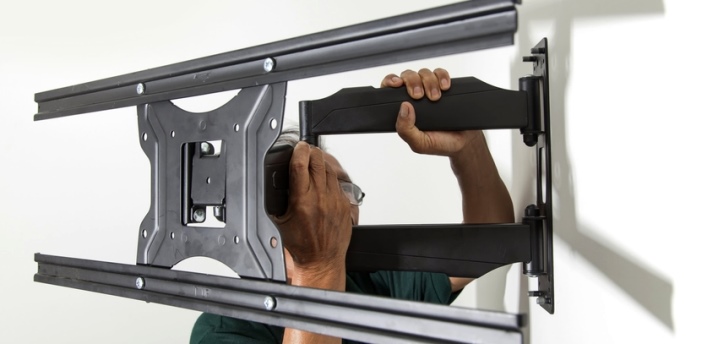
Turning
The bracket on a swivel base allows not only to rotate the TV along one of the axes of movement, but also to push it forward a little, somewhat closer to the user... This view makes it possible to increase the distance from the wall - in the case when the sofa or chair is moved. More advanced models are equipped with electronics and power electrics, which independently change the position of the TV or monitor relative to the wall, turning it in the right direction at the right angle. Control is carried out from the remote control included in the kit. The disadvantage of these constructs is high cost, sometimes reaching a difference of several times - compared to similar devices that do not have this function.


Angular
It is permissible to place a TV device in the corner of the room. Sometimes it will even additionally decorate the corner, in which there is still nothing more remarkable and improving the design of the room.... The advantage of the design is a significant saving of space near any of the walls. Many users appreciate this solution. The fact is that, in fact, a corner bracket is a pivoting suspension for TV and monitors, which allows you to unfold the display as the owners of the room wish. But the corner holder is a more versatile solution than its previous sibling: it would find a place closer to the middle of the wall where the LCD panel should stand.

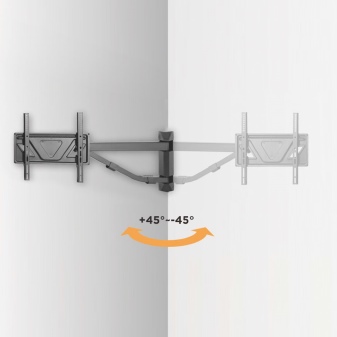
Swivel-tilt
This type is considered even more universal mount than both previous ones.Most of the products of this type are not equipped with any electronic automation: the panel is rotated by the movement of the user's hand. This is a worthy solution for especially discerning consumers. But it is also more expensive. However, this fact does not repel people for whom the LCD panel is a full-fledged media center for the home.
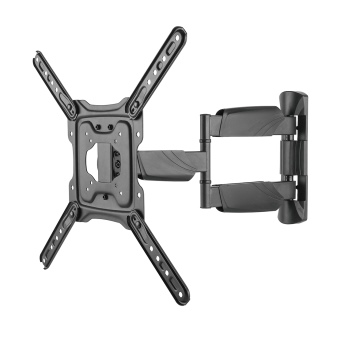
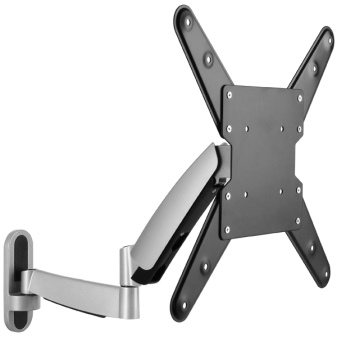
So, owners of monitors with wired and wireless projection, to which even a smartphone with 4K video resolution can be connected, will definitely stop at this solution.
Fixed
This type is disadvantageously different from the three previous ones. Despite the obvious low cost, it is also available for self-production. Even a holder pipe is not needed for such a mount. It is enough to install four rails, two of which, the lower ones, will turn out to be angular: they will not let the monitor fall down thanks to their mounting edges. The extension pipe is mounted only in cases where a swivel mechanism is not provided in the bracket, but it is still necessary to "squeeze" the TV panel into the corner between two adjacent walls or between the wall and the ceiling. But these brackets can be equipped with a telescopic (retractable) pipe, which allows them to fit into any corner or transition formed by nearby walls.
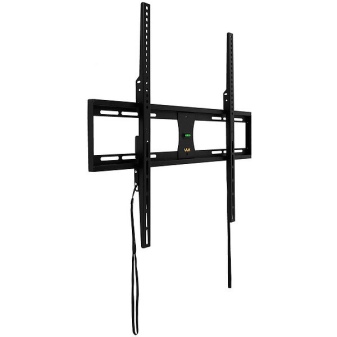

How to choose?
It does not matter what the diagonal of the TV panel is - 32, 40, 42, 43, 49, 50, 55, 65 or 75 inches, the powerful bracket will withstand any device, since it has almost ten times the allowed weight of the lifted equipment. The dimensions of the brackets can vary from 100x75 to 400x400. These are the dimensions of the plate, which is located closest to the back wall of the monitor - it allows you to keep the panel relatively motionless, without distortions. The user can use a bracket with a mount, for example, 200x200, while his display supports the 100x100 mount standard, but not vice versa. If you interpret this rule the other way around, the monitor may fall and break. The larger the diagonal of the monitor or TV, the more overall is the mount for the bracket: it is logical to assume that 100x100 would fit a 32-inch monitor, while 400x400 would withstand a 75-inch panel. 300x300 can be used with diagonals of say 48-55 inches.
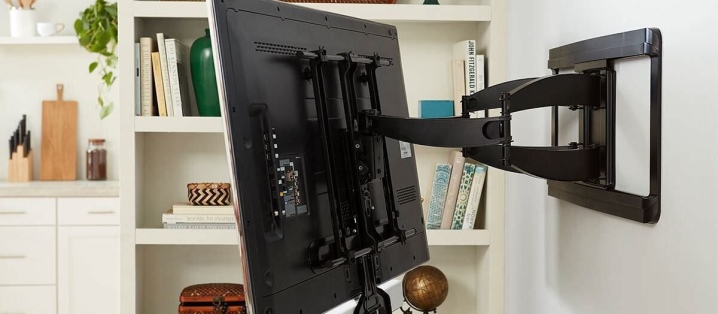
The final choice of the bracket is influenced by the following factors:
- saving free space in the room;
- lifting the panel to a height unattainable for children and pets;
- protection against accidental mechanical damage - for example, breaking the screen;
- an organic combination with the interior of the living space.
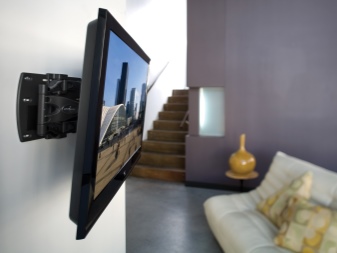
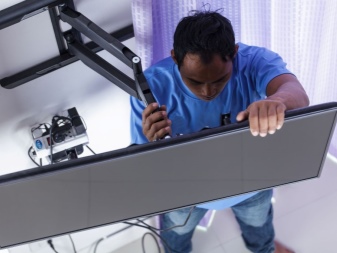
When making a choice in favor of wall placement of the TV panel, the user should take into account that it will be necessary to choose the right fasteners and no less accurately carry out the suspension of the equipment in the place intended for it. The most significant parameter is the allowed mass of the TV device. A bracket that can withstand 15 kg should not be bought for a panel of the same mass: one light and careless movement - and the structure will break, and with it the device itself will be lost. Prefer a bracket with a two-fold, or better, a three-fold overweight.
The type of bracket must be suitable for the diagonal of the device. The model description indicates the recommended range of values, one of which your device possesses.
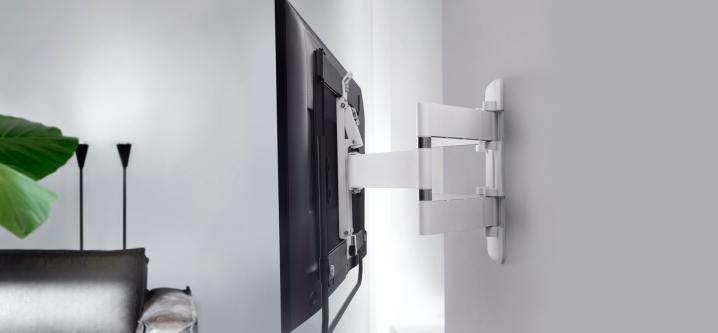
Other characteristics include a compartment that hides extra centimeters of cables inside, additional shelves for speakers or placement of a media set-top box... Finally, the colors can match the panel colors - or be close to them. Whether it will be white or, for example, brown, to match the color of cabinets and furniture walls, depends on the real design of a country house or apartment.
The brackets are VESA marked. This does not mean that all other products will turn out to be fakes, but it is worth checking what they are made of. Plastic and aluminum are not as trustworthy as steel. If the bracket does not meet this standard, then it will be difficult to hang the TV on it: it may need to be redone.
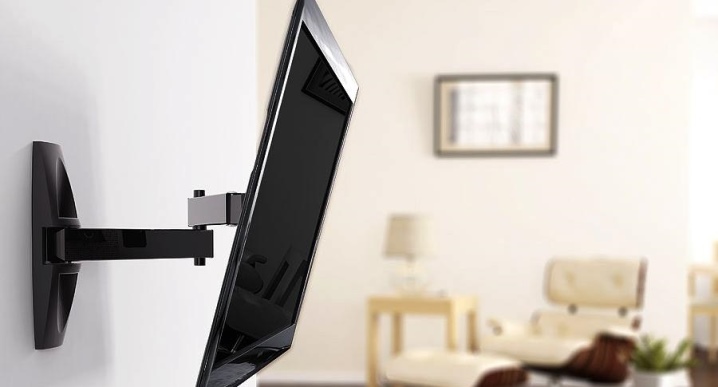
Popular models
For 2021, the top eight bracket models have been identified with the highest demand. However, this situation changes up to several times a year.
- Kromax Techno-1 (dark gray) is made of aluminum. Designed for devices from 10 to 26 inches. Permitted weight - 15 kg. The contact area is available in 75x75 and 100x100 mm formats. Rotation of the panel vertically - 15, horizontally - 180 degrees. Product weight - more than 1 kg, durability is guaranteed.
- Digis DSM21-44F is designed for devices from 32 to 55 inches. Mount - for 200x100, 200x200, 300x300 and 400x400 mm. The attachment point of the suspension is only 2.7 cm away from the wall. A bubble-liquid level gauge is located on one of the posts - the installation of the product is extremely simplified due to this feature.
- Digis DSM-P4986 - the product, designed for 40-90 "panels, can withstand the weight of devices up to 75 kg.
- NB C3-T is suitable for 37- 60 "panels. Designed for a contact area of 200x100, 200x200, 300x300, 400x400 and 600x400 mm. Tilts up to 12 degrees. Product weight - 3 kg. Covered with an antioxidant layer - it will withstand, for example, operation in the kitchen, where humidity and temperature can differ significantly.
- North Bayou C3-T designed for TV panels and monitors 32-57 inches. Ceiling. Fastening - 100x100, 100x200, 200x200, 300x300, 200x400, 400x400 and 400x600 mm. The sliding pipe allows you to tilt the TV 20 degrees, and turn it all 60. The weight of the structure is 6 kg, it requires fasteners with through (studs, spring washers and press washers with nuts) or deep (anchor) drilling of the wall.
- North Bayou T560-15 - tilt and swivel, oriented to TV panels up to 60 inches and weighing a maximum of 23 kg. Standard contact pads: 75x75, 100x100, 200x100, 200x200, 300x300 and 400x400 mm. A pair of air shock absorbers is used, which allows the panel to be smoothly turned in the desired direction. Tilts 15 degrees, rotates 180 degrees. Equipped with a cable compartment.
- North Bayou F400 - tilting and swiveling, for panels 26-42 inches. The permitted weight of the device is 18 kg. Contacts at 200x100, 200x200, 300x300 and 400x400 mm. Steel. It can be rotated vertically by 20 degrees, the horizontal tilt can be adjusted by 180. The distance from the wall to the back of the panel is 3.5 cm.
- Vogel's THIN 445 - ceiling construction. The mechanical stepping motor, controlled from the console module, makes it possible to rotate the arm without mechanical intervention of the user, at an angle, up to 90 degrees, up and down, to the sides. Designed for media consoles and panels in the size of 40-70 inches. The permitted weight of the device is 10 kg. Mounts for 200x200, 300x300 and 400x400 mm. Ceiling-niche execution. Suitable for rooms with ceilings from 3 to 3.5 m in height - due to the 11 cm thickness of the fixing.
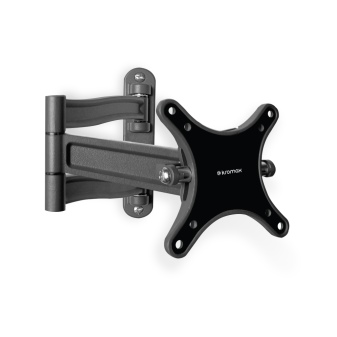
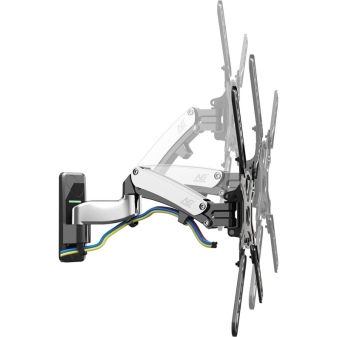
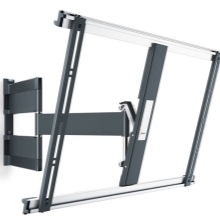
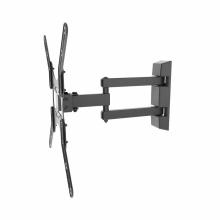

There are hundreds of other constructions not listed in this list. The rating of the mounts depends on the real feedback from visitors to online stores.
How to hang correctly?
To place a TV, monitor or media attachment panel on the wall, including a monoblock computer, take the installation seriously enough. The place of installation is chosen taking into account not only the wishes of the user, but also in accordance with how his living space is furnished. So, the side seat is often shifted closer to the corner in the room. The work performed with significant violations is fraught with the loss of an expensive device - especially after its fall from a 1.5-3-meter height. The master will take into account all the requirements and will hang up the monitor or TV so that it will work for many years without any remarks. Before installing the mounts, read the instructions in the user manual: accurate and correct assembly order is important.
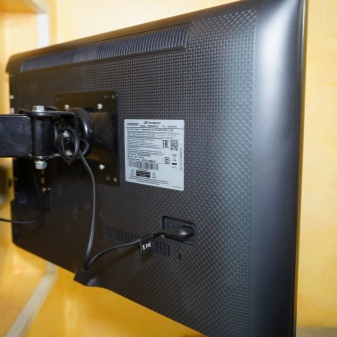
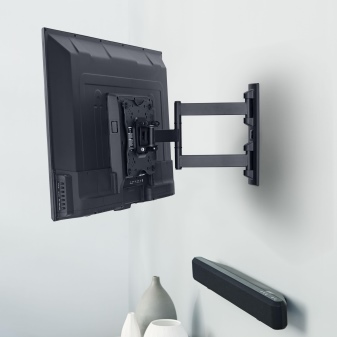
The technique should not seriously disrupt the arrangement of other things and objects in the room. - on the contrary, its location harmoniously fits into what is already nearby. So, in a small kitchen of 5-6 square meters it is not worth placing a 75-inch panel: a normally seeing person, without myopia, as well as people with age-farsightedness, a too close a widescreen display will cause discomfort. Place the monitor on an empty wall - where there are no interior decorations, paintings and reproductions, wall lights, etc. The fact is that a high-tech and expensive device is not just a kind of media attachment, but also an additional interior decoration.
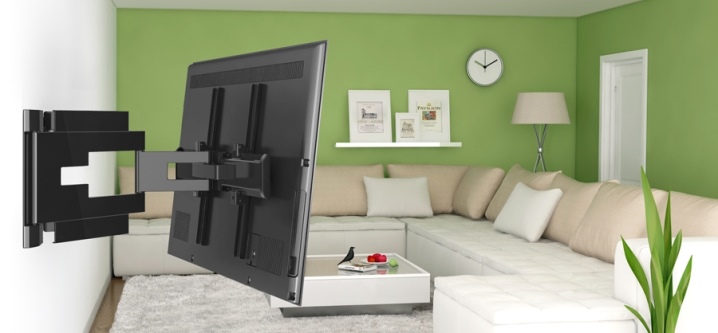
The panel should not be located next to the heating radiator - and it does not matter if it is water or oil (electric). It is unacceptable to place the panel over a stove, oven, in the immediate vicinity of an oven, near a microwave oven or a heating boiler, which also emits significant heat. It is also forbidden for the panel to overheat in the summer heat in the sun.
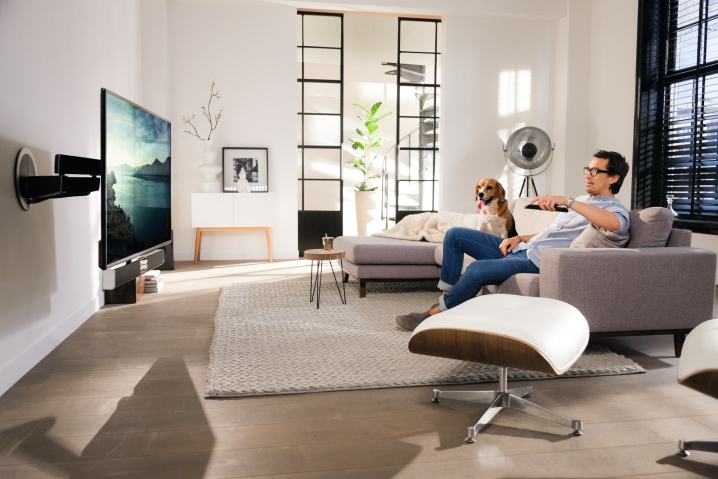
Before positioning the panel, make sure that there is a free socket nearby, or place an extension cord nearby. Some users put extension cords on the wall - as sockets. The closer the outlet is to the TV panel, the less wires and cables are visible to everyone present. Finally, watching television and videos should not be inconvenient for viewers seated on a couch or sitting at a table.
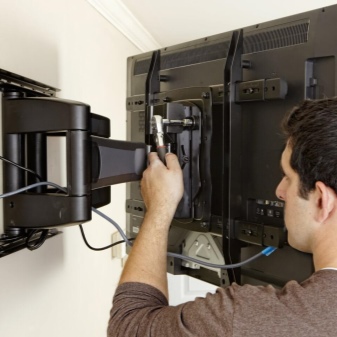
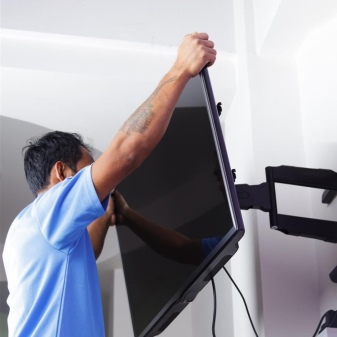
If there are shelves nearby, for example, for speakers, then they should not cause a sharp dissonance in combination with a TV panel.
The height of the device must not be less than 70 cm from the floor to the bottom edge. Ceiling mounting is provided in long rooms - from 5 m, especially when spectators are located at the far end of the room.

Follow these steps to assemble the bracket and hang the device on it.
- Mark the holes for the mount on the wall, using the latter as a stencil.
- Drill holes for anchor bolts or through studs. Screw in and secure the hardware. So, the anchors are screwed in and pressed in thanks to the spacer mechanism in each of them.
- Hang the movable and fixed parts of the bracket and screw it to the wall.
- Install and secure the TV or monitor to the bracket mounting bracket. Make sure everything is tightened securely.
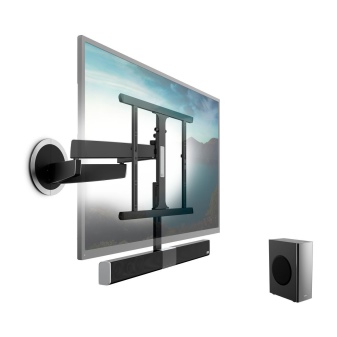
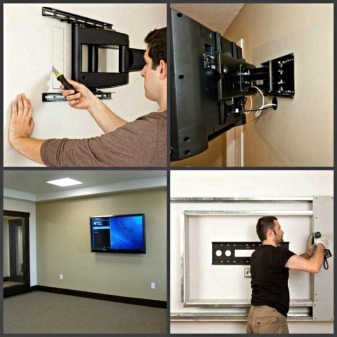
Connect the device to the power supply and to a video signal source. This can be a TV antenna, a set-top box, an IPTV module, a smartphone or tablet, a LAN cable of a local area network of a router connected to the Internet, etc.
It is strictly forbidden to hang old CRT TVs. Due to the large dimensions, the center of gravity of the device can move, and the bracket will be skewed, which does not exclude the fall of the equipment. The place of old TVs with a picture tube is on a floor (not wall-mounted) cabinet, as well as on a stand-type stand. Due to its low weight (no more than 3 kg), the ultra-thin monitor does not need a bracket at all; a simple tabletop tripod is also suitable for it, including a motorized one and is as thin as the gadget itself.
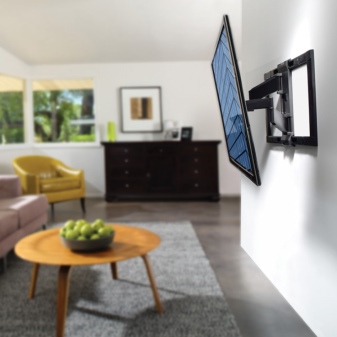
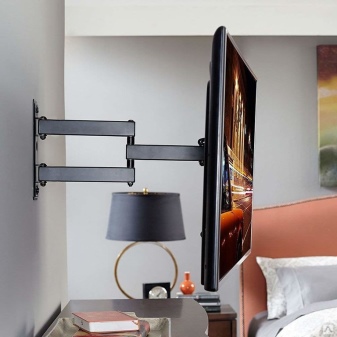
If the instruction manual contains a marking template, then you will not need to draw an additional line on the wall. It is enough just to attach it to the place where the bracket is installed, mark the points where the holes are drilled, then install the bracket parts using standard or separate fasteners. If the kit does not have its own fasteners, anchor bolts and / or a stud with accompanying additional elements are used.
Some especially cautious users anticipate all abnormal situations associated with the reliability of mounting the bracket, and in advance install the best, high-strength fasteners that they could get at the nearest hardware store. Parts of the suspension structure are attached to it.
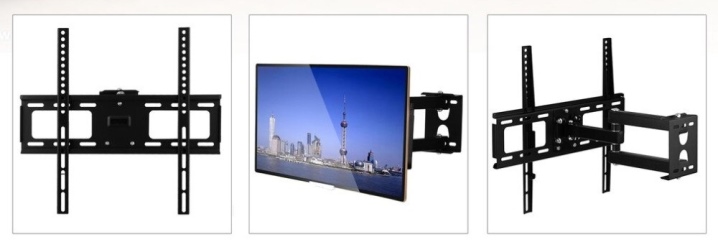
This video shows you how to mount the TV bracket to the wall in detail.













The comment was sent successfully.